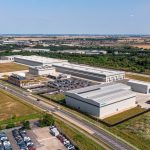News - Construction News
New Rail Innovation Centre launched by Balfour Beatty

Balfour Beatty has officially launched a new Rail Innovation Centre at the infrastructure specialist’s Raynesway facility in Derbyshire.
The Rail Innovation Centre will be a dedicated research, development and testing resource supporting the development of the ‘digital railway’ – defined as being a more resilient, cost effective and secure transport network worthy of the 21st century.
The hub will pool expertise from Balfour Beatty’s own computer science, data analytics, mechanical and electrical, and systems engineering departments. It will also house the latest developments in data science, measurement systems, ‘predict & prevent’ technology and signalling.
Each of these technologies builds upon established systems and represents the cutting edge in artificial intelligence including machine learning and machine vision systems, and the application of robot testing to enable the remote, unattended high-speed testing of rail infrastructure in a controlled environment.
“Digital technologies are rapidly changing the rail industry, bringing new efficiencies and presenting new opportunities,” said Mark Bullock, Chief Executive Officer for Rail and Utilities at Balfour Beatty. “The Rail Innovation Centre is at the heart of Balfour Beatty’s technology offering with the specific purpose of driving efficiencies and safety across the rail network for those who work on the railway and ultimately the travelling public.”
Crucially. the Rail Innovation Centre will generate high value jobs across a diverse range of disciplines, allowing Balfour Beatty to maintain and grow its graduate and technical schemes and nurture the next generation of rail engineers. The business expects to employ four graduates, five apprentices and three trainees initially.
The new facility will also enable greater collaboration and knowledge sharing between a host of stakeholders and industry partners, strengthening Balfour Beatty’s ongoing relationship with the data science community and forging mutually beneficial links with academia.
If you would like to read more articles like this then please click here.
Related Articles
More News
- £8Bn to be invested in flood defences over the next decade
27 Jun 25
A record £7.9Bn over ten years has been committed to flood defences.
- Boosting British jobs and skills key for firms to win major infrastructure projects
26 Jun 25
Creating high quality British jobs and boosting skills in local communities will be key requirements
- Major rail supply deal to protect thousands of British Steel jobs
25 Jun 25
Thousands of British manufacturing jobs have been secured as the Transport Secretary finalises a major






